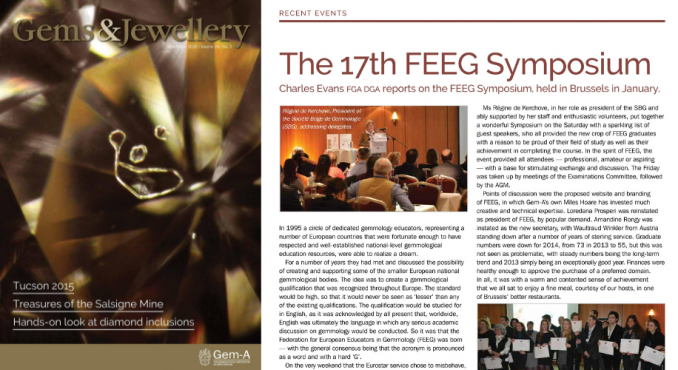Media
Articles, Press Releases, Images and Webinars
Articles, Press Releases, Images and Webinars

Written for industry specialists, this article challenges the conventional approach to the teaching of Colour Filters, which tends to view them as an entirely separate tool and learning concept. I suggest this could be improved and doing so would empower students with a deeper understanding of the filtering of light, and the wider influence of transitional elements, while also bettering the understanding of the graphic output of spectroscopic data, and the concepts of absorption and emission. Students often struggle to relate what they see through a colour filter with what they see in a graph.
Continue reading “Colour Filters: Useful tools that gemologists should use but often don’t”
My first visit to Hong Kong was in 1997 and I loved it. Over the years it has been home to some amazing gemmologists and when I was working with Gem-A, there was a fantastic team based in a city that has more gemmology schools in a few square miles than the whole of the UK.
In 2020, when I was asked if I could put some thoughts into words for the annual Journal of the Gemmological Association of Hong Kong, I was flattered and used the opportunity to focus and reflect on some of my long-standing beliefs.
Continue reading “Being Proud of Those in the Gemstone Supply Chain”
One of the most important discoveries in the history of diamond mining was that diamonds were found in kimberlite. Until then, the world had obtained diamonds from Golconda and Brazil where they were found in alluvial gravels. The town where this was discovered was called Kimberley in South Africa and in geological terms, Kimberley is the ‘type locality’ of kimberlite. As part of the Gem-A Live series, I was asked to deliver a webinar on the town of Kimberley, discussing the significance of the diamond discoveries not only to the town and to South Africa as a whole, but also on the diamond industry worldwide.
Continue reading “Webinar: 150 Years of Diamond Mining in Kimberley”

Someone well-known to gemmologists, mineralogists and, indeed, anyone with a keen interest in gems, minerals and great photography, is Gloria Staebler.
Through Gloria, I was included in an investigation to verify something she had noticed in the course of her research, and I was proud to be able to contribute. We were asked to verify if the Ashmolean Museum in Oxford had correctly identified a gemstone carving of Alexander the Great as Tourmaline. In which case it would be the world’s oldest known tourmaline carving, predating that currently believed to be the oldest by 500years.
Continue reading “The Discovery of the Oldest Known Tourmaline Carving”

It is not often that a gemmologist gets to see something from Antarctica, a continent that still enjoys the protection of the 1961 international treaty intended to protect and preserve the untapped uniqueness of the biosphere from the rapacious consumption of mankind. This Gem Note, featured in the Journal of Gemmology, covers an exciting opportunity that presented itself when faceted samples from a research trip to Mount Erebus reached the laboratory. I could get the graphs and numbers from the battery of laboratory equipment, but it was Nathan Renfro’s brilliant photomicrography that captured the essence of these samples.
Continue reading “Rare Opportunity: Gemstones from Antarctica”

This image appears a simple one, two men showing me what they had found that morning on their ‘dig’ in Elahara, Sri Lanka. This was a field trip that we ran in conjunction with the National Association of Jewellers and took a mixture of gemmologists and jewellers to this incredible island nation to discover just what made it so unique and special. Beyond the image is a bigger story. These men are farmers for half the year and then their farmland becomes a mine-site.
Continue reading “Sustainability in Artisanal Sapphire Mining”

There are many resources available that will assist the well-heeled and established jewellery companies in their mission to bring transparency to their supply chain and to reassure clients that they are addressing ESG concerns (Ethics, Sustainability and Governance.) Where does one start when you are a small start-up? What about those for whom the founding ethos of the business is to empower women, showcase a region and bring to market its gems while ensuring every little step would pass any scrutineer? This is the story of an intense mission that set out to do just that.
Continue reading “Ethics, Sustainability and Governance in the Swat Valley”

The Federation of European Educators in Gemmology (FEEG) was founded in the early nineties by a few of Europe’s prominent gemmology schools seeking a way to broaden the opportunities for gemmology students in Europe. Many of the national associations are staffed by very dedicated volunteers and excellent gemmologists and the programmes they run produce outstanding graduates, but due to the small organizations and cohorts, their students are not afforded the international recognition they deserve. FEEG is an educational body that runs exams twice a year across much of Europe and in the language of all the participating nations.
Continue reading “The Importance and Value of Being a European Gemmologist (EG)”